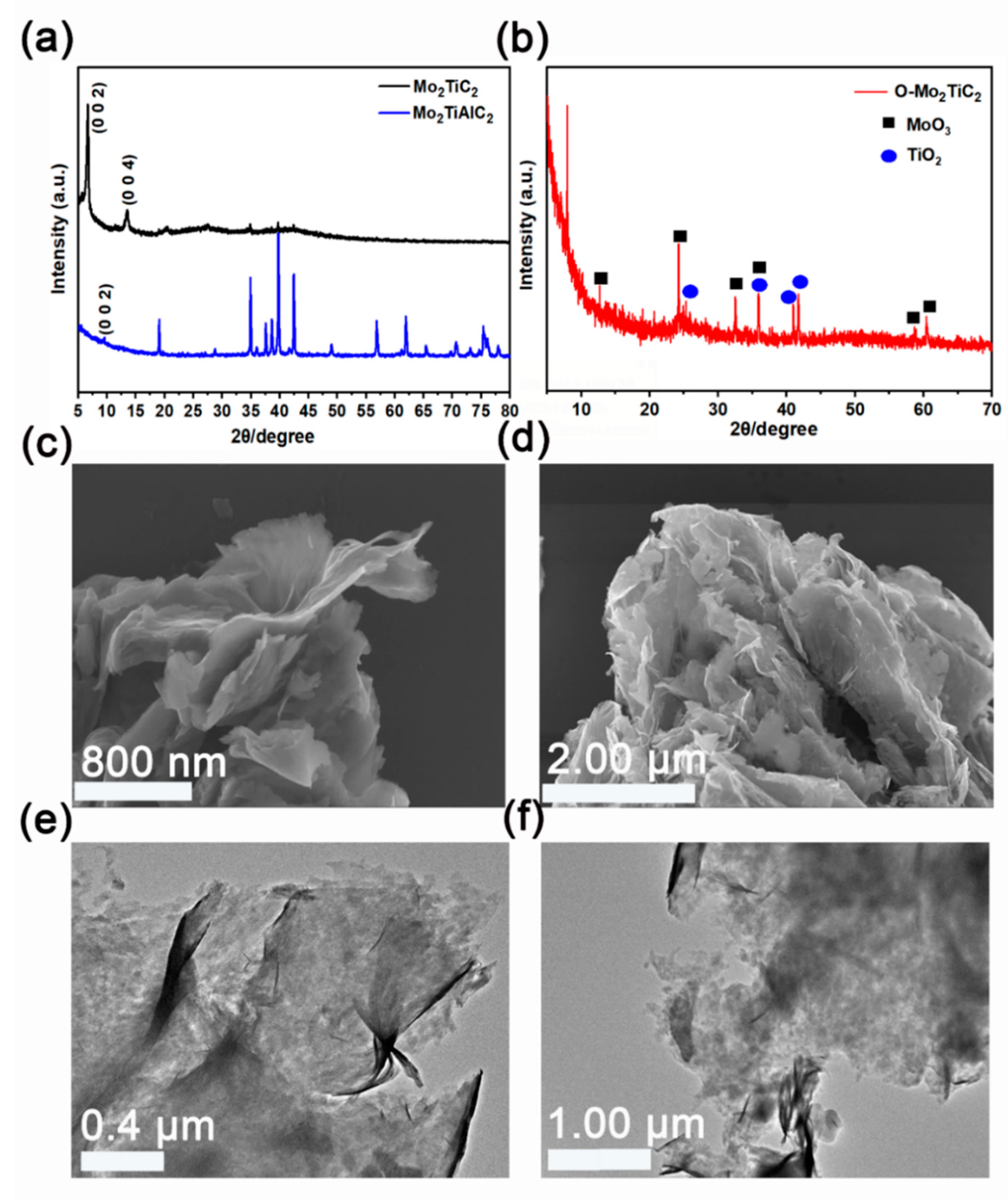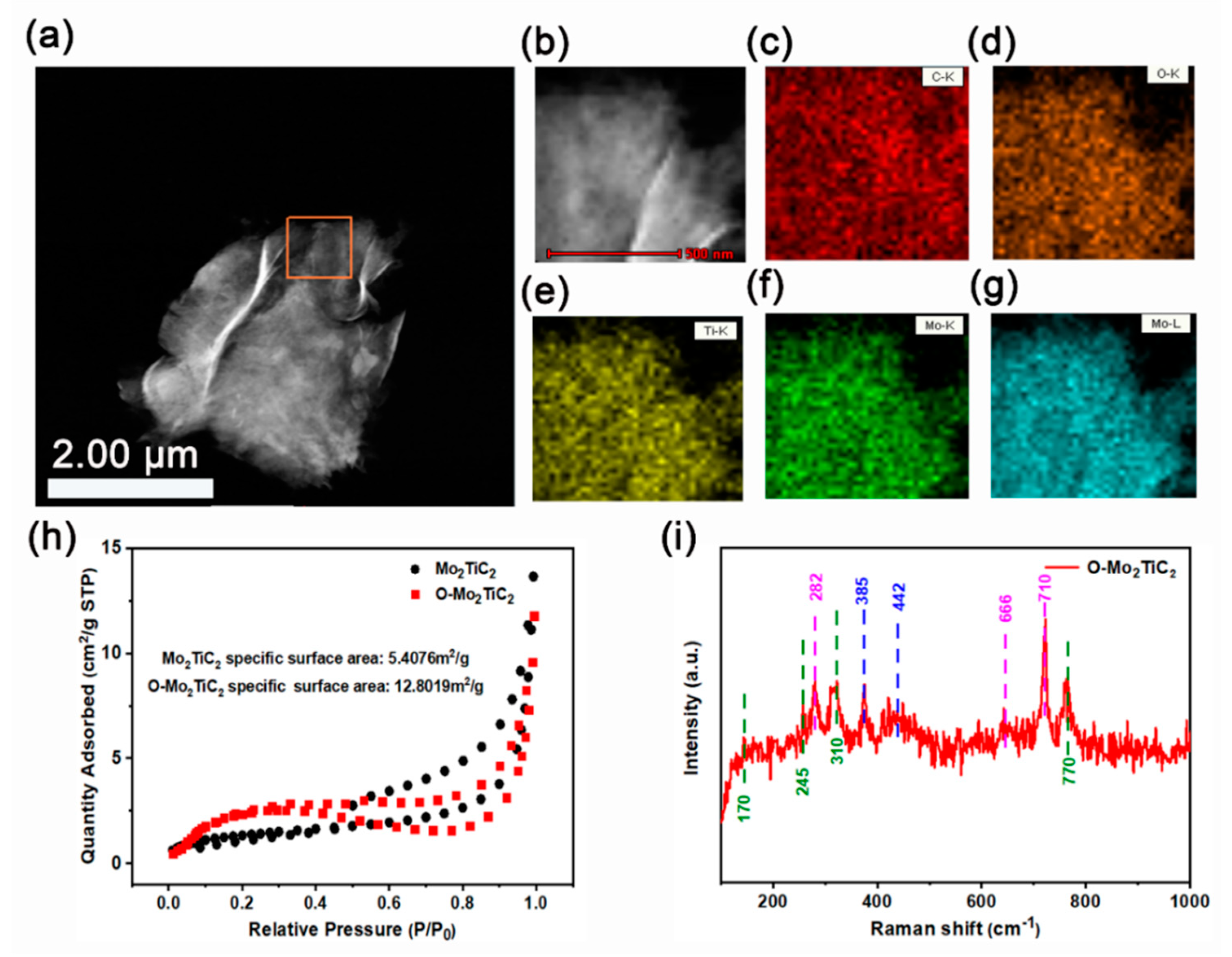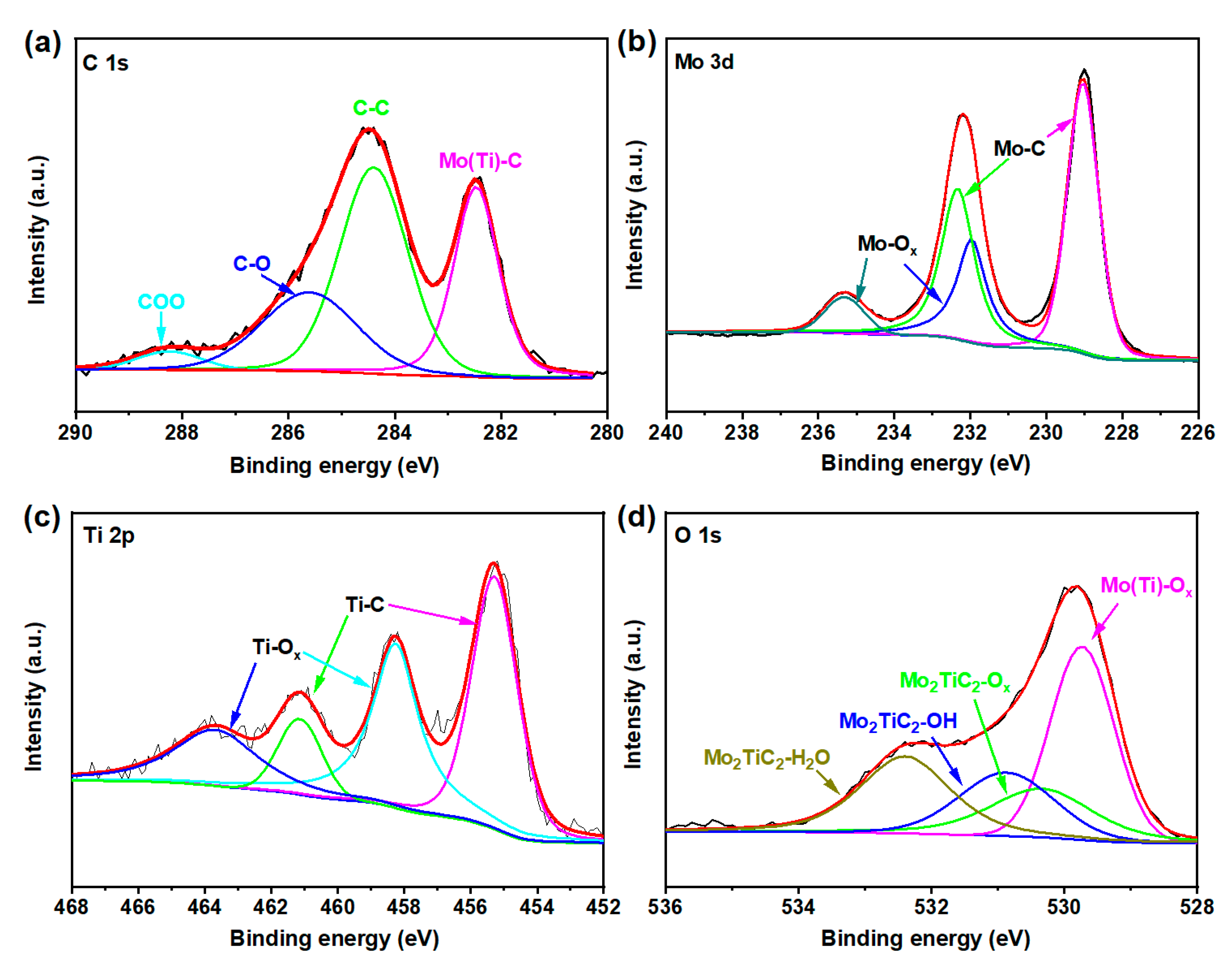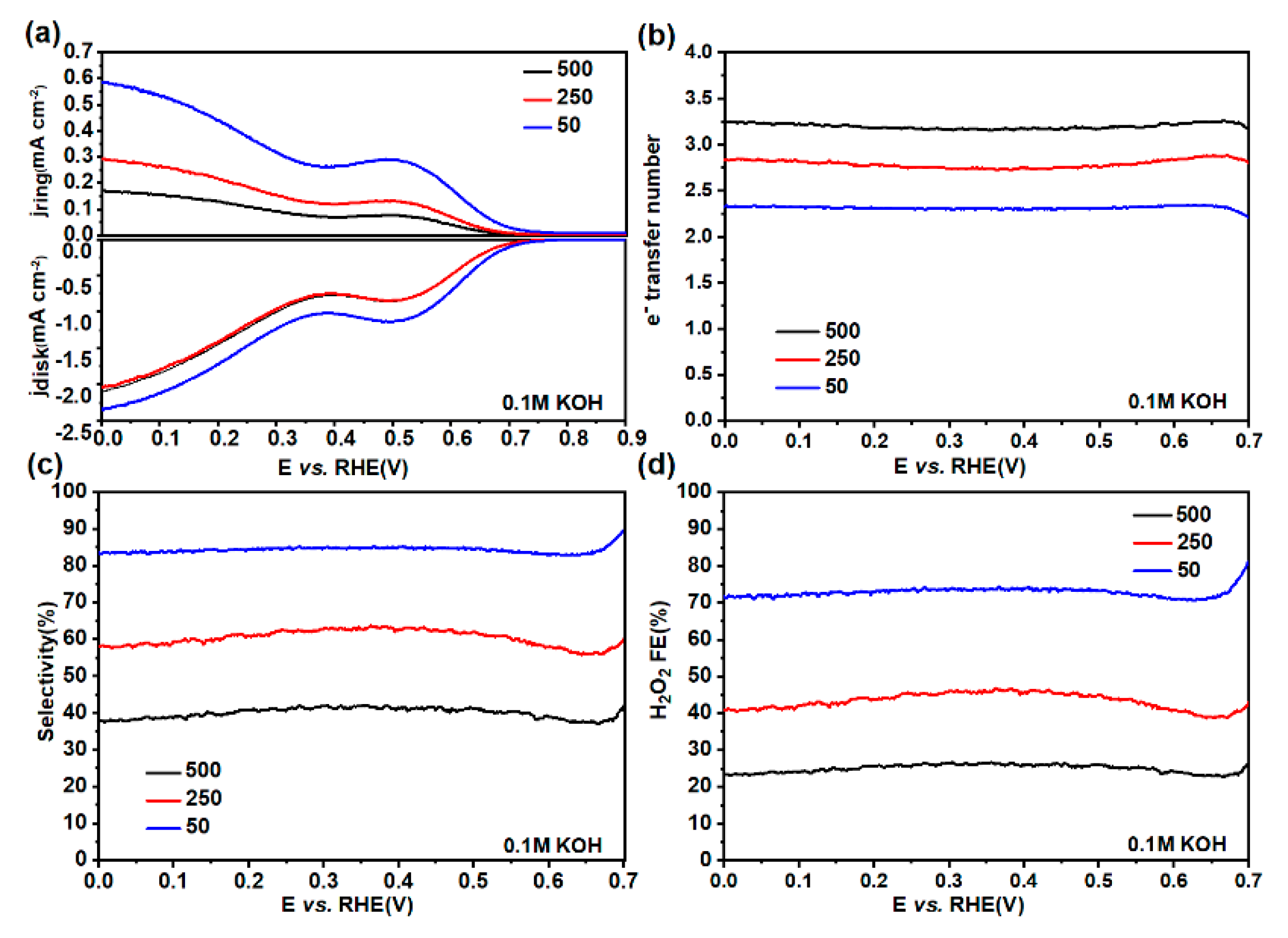High-Efficiency Oxygen Reduction to Hydrogen Peroxide Catalyzed by Oxidized Mo2TiC2 MXene
Abstract
:1. Introduction
2. Results and Discussion
3. Materials and Methods
3.1. Reagents and Chemicals
3.2. Synthesis of Mo2TiC2 MXene and O-Mo2TiC2
3.2.1. Synthesis of Mo2TiC2 MXene
3.2.2. Synthesis of Oxidized Mo2TiC2-Based MXene Materials
3.3. Characterization of Mo2TiC2 MXene and O-Mo2TiC2
3.4. Electrochemical Performance Tests
- (1)
- Catalyst preparation:
- (2)
- RRDE measurement:
- (3)
- Electrochemical impedance spectroscopy (EIS) was acquired in the range of 106 Hz to 0.1 Hz, measured in an oxygen-saturated 0.1 M KOH aqueous solution at 0.65 V vs. RHE. All measurement potentials using the three-electrode setup are manually 100% compensated.
- (4)
- The stability of the catalyst in this experiment was tested by the potentiostatic method, and the catalyst was tested under fixed voltage conditions for 40 h (0.7 V vs. RHE).
3.5. Mechanism
4. Conclusions
Supplementary Materials
Author Contributions
Funding
Data Availability Statement
Conflicts of Interest
References
- Xia, Y.; Zhao, X.; Xia, C.; Wu, Z.-Y.; Zhu, P.; Kim, J.Y.; Bai, X.; Gao, G.; Hu, Y.; Zhong, J.; et al. Highly Active and Selective Oxygen Reduction to H2O2 on Boron-Doped Carbon for High Production Rates. Nat. Commun. 2021, 12, 4225. [Google Scholar] [CrossRef] [PubMed]
- Shah, A.U.H.A.; Inayat, A.; Bilal, S. Enhanced Electrocatalytic Behaviour of Poy(Aniline-Co-2-Hydroxyaniline) Coated Electrodes for Hydrogen Peroxide Electrooxidation. Catalysts 2019, 9, 631. [Google Scholar] [CrossRef] [Green Version]
- Song, W.; Zhao, R.; Yu, L.; Xie, X.; Sun, M.; Li, Y. Enhanced Catalytic Hydrogen Peroxide Production from Hydroxylamine Oxidation on Modified Activated Carbon Fibers: The Role of Surface Chemistry. Catalysts 2021, 11, 1515. [Google Scholar] [CrossRef]
- Sun, F.; Yang, C.; Qu, Z.; Zhou, W.; Ding, Y.; Gao, J.; Zhao, G.; Xing, D.; Lu, Y. Inexpensive Activated Coke Electrocatalyst for High-Efficiency Hydrogen Peroxide Production: Coupling Effects of Amorphous Carbon Cluster and Oxygen Dopant. Appl. Catal. B 2021, 286, 119860. [Google Scholar] [CrossRef]
- Huynh, T.-T.; Huang, W.-H.; Tsai, M.-C.; Nugraha, M.; Haw, S.-C.; Lee, J.-F.; Su, W.-N.; Hwang, B.J. Synergistic Hybrid Support Comprising TiO2–Carbon and Ordered PdNi Alloy for Direct Hydrogen Peroxide Synthesis. ACS Catal. 2021, 11, 8407–8416. [Google Scholar] [CrossRef]
- Pan, C.; Zheng, Y.; Yang, J.; Lou, D.; Li, J.; Sun, Y.; Liu, W. Pt–Pd Bimetallic Aerogel as High-Performance Electrocatalyst for Nonenzymatic Detection of Hydrogen Peroxide. Catalysts 2022, 12, 528. [Google Scholar] [CrossRef]
- Chen, S.; Luo, T.; Chen, K.; Lin, Y.; Fu, J.; Liu, K.; Cai, C.; Wang, Q.; Li, H.; Li, X.; et al. Chemical Identification of Catalytically Active Sites on Oxygen-doped Carbon Nanosheet to Decipher the High Activity for Electro-synthesis Hydrogen Peroxide. Angew. Chem. Int. Ed. 2021, 60, 16607–16614. [Google Scholar] [CrossRef] [PubMed]
- Liu, C.; Li, H.; Chen, J.; Yu, Z.; Ru, Q.; Li, S.; Henkelman, G.; Wei, L.; Chen, Y. 3d Transition-Metal-Mediated Columbite Nanocatalysts for Decentralized Electrosynthesis of Hydrogen Peroxide. Small 2021, 17, 2007249. [Google Scholar] [CrossRef] [PubMed]
- Liu, Y.; Chen, Y.; Deng, J.; Wang, J. N-Doped Aluminum-Graphite (Al-Gr-N) Composite for Enhancing in-Situ Production and Activation of Hydrogen Peroxide to Treat Landfill Leachate. Appl. Catal. B 2021, 297, 120407. [Google Scholar] [CrossRef]
- Wu, Y.; Li, Y.; Gao, J.; Zhang, Q. Recent Advances in Vacancy Engineering of Metal-organic Frameworks and Their Derivatives for Electrocatalysis. SusMat 2021, 1, 66–87. [Google Scholar] [CrossRef]
- Chen, Z.; Chen, S.; Siahrostami, S.; Chakthranont, P.; Hahn, C.; Nordlund, D.; Dimosthenis, S.; Nørskov, J.K.; Bao, Z.; Jaramillo, T.F. Development of a Reactor with Carbon Catalysts for Modular-Scale, Low-Cost Electrochemical Generation of H2O2. React. Chem. Eng. 2017, 2, 239–245. [Google Scholar] [CrossRef]
- Li, W.; Bonakdarpour, A.; Gyenge, E.; Wilkinson, D.P. Drinking Water Purification by Electrosynthesis of Hydrogen Peroxide in a Power-Producing PEM Fuel Cell. ChemSusChem 2013, 6, 2137–2143. [Google Scholar] [CrossRef] [PubMed]
- Cao, K.; Yang, H.; Bai, S.; Xu, Y.; Yang, C.; Wu, Y.; Xie, M.; Cheng, T.; Shao, Q.; Huang, X. Efficient Direct H2O2 Synthesis Enabled by PdPb Nanorings via Inhibiting the O–O Bond Cleavage in O2 and H2O2. ACS Catal. 2021, 11, 1106–1118. [Google Scholar] [CrossRef]
- Wang, Y.; Waterhouse, G.I.N.; Shang, L.; Zhang, T. Electrocatalytic Oxygen Reduction to Hydrogen Peroxide: From Homogeneous to Heterogeneous Electrocatalysis. Adv. Energy Mater. 2021, 11, 2003323. [Google Scholar] [CrossRef]
- Menegazzo, F.; Signoretto, M.; Ghedini, E.; Strukul, G. Looking for the “Dream Catalyst” for Hydrogen Peroxide Production from Hydrogen and Oxygen. Catalysts 2019, 9, 251. [Google Scholar] [CrossRef] [Green Version]
- Wen, Y.; Li, R.; Liu, J.; Wei, Z.; Li, S.; Du, L.; Zu, K.; Li, Z.; Pan, Y.; Hu, H. A Temperature-Dependent Phosphorus Doping on Ti3C2Tx MXene for Enhanced Supercapacitance. J. Colloid Interface Sci. 2021, 604, 239–247. [Google Scholar] [CrossRef] [PubMed]
- Pan, Y.; Abazari, R.; Wu, Y.; Gao, J.; Zhang, Q. Advances in Metal–Organic Frameworks and Their Derivatives for Diverse Electrocatalytic Applications. Electrochem. Commun. 2021, 126, 107024. [Google Scholar] [CrossRef]
- Back, S.; Na, J.; Ulissi, Z.W. Efficient Discovery of Active, Selective, and Stable Catalysts for Electrochemical H2O2 Synthesis through Active Motif Screening. ACS Catal. 2021, 11, 2483–2491. [Google Scholar] [CrossRef]
- Hu, Y.; Zhang, J.; Shen, T.; Li, Z.; Chen, K.; Lu, Y.; Zhang, J.; Wang, D. Efficient Electrochemical Production of H2O2 on Hollow N-Doped Carbon Nanospheres with Abundant Micropores. ACS Appl. Mater. Interfaces 2021, 13, 29551–29557. [Google Scholar] [CrossRef] [PubMed]
- Jiang, K.; Back, S.; Akey, A.J.; Xia, C.; Hu, Y.; Liang, W.; Schaak, D.; Stavitski, E.; Nørskov, J.K.; Siahrostami, S.; et al. Highly Selective Oxygen Reduction to Hydrogen Peroxide on Transition Metal Single Atom Coordination. Nat. Commun. 2019, 10, 3997. [Google Scholar] [CrossRef] [Green Version]
- Kim, H.W.; Ross, M.B.; Kornienko, N.; Zhang, L.; Guo, J.; Yang, P.; McCloskey, B.D. Efficient Hydrogen Peroxide Generation Using Reduced Graphene Oxide-Based Oxygen Reduction Electrocatalysts. Nat. Catal. 2018, 1, 282–290. [Google Scholar] [CrossRef] [Green Version]
- Zhang, Y.; Lyu, Z.; Chen, Z.; Zhu, S.; Shi, Y.; Chen, R.; Xie, M.; Yao, Y.; Chi, M.; Shao, M.; et al. Maximizing the Catalytic Performance of Pd@AuxPd1−x Nanocubes in H2O2 Production by Reducing Shell Thickness to Increase Compositional Stability. Angew. Chem. Int. Ed. 2021, 60, 19643–19647. [Google Scholar] [CrossRef] [PubMed]
- Mavrikis, S.; Göltz, M.; Perry, S.C.; Bogdan, F.; Leung, P.K.; Rosiwal, S.; Wang, L.; Ponce de León, C. Effective Hydrogen Peroxide Production from Electrochemical Water Oxidation. ACS Energy Lett. 2021, 6, 2369–2377. [Google Scholar] [CrossRef]
- Li, Z.; Zhang, X.; Kang, Y.; Yu, C.C.; Wen, Y.; Hu, M.; Meng, D.; Song, W.; Yang, Y. Interface Engineering of Co-LDH@MOF Heterojunction in Highly Stable and Efficient Oxygen Evolution Reaction. Adv. Sci. 2021, 8, 2002631. [Google Scholar] [CrossRef] [PubMed]
- Li, Z.; Ma, C.; Wen, Y.; Wei, Z.; Xing, X.; Chu, J.; Yu, C.; Wang, K.; Wang, Z.-K. Highly Conductive Dodecaborate/MXene Composites for High Performance Supercapacitors. Nano Res. 2020, 13, 196–202. [Google Scholar] [CrossRef]
- Jung, E.; Shin, H.; Lee, B.-H.; Efremov, V.; Lee, S.; Lee, H.S.; Kim, J.; Hooch Antink, W.; Park, S.; Lee, K.-S.; et al. Atomic-Level Tuning of Co–N–C Catalyst for High-Performance Electrochemical H2O2 Production. Nat. Mater. 2020, 19, 436–442. [Google Scholar] [CrossRef]
- Wang, N.; Ma, S.; Zuo, P.; Duan, J.; Hou, B. Recent Progress of Electrochemical Production of Hydrogen Peroxide by Two-Electron Oxygen Reduction Reaction. Adv. Sci. 2021, 8, 2100076. [Google Scholar] [CrossRef] [PubMed]
- Sun, Y.; Silvioli, L.; Sahraie, N.R.; Ju, W.; Li, J.; Zitolo, A.; Li, S.; Bagger, A.; Arnarson, L.; Wang, X.; et al. Activity–Selectivity Trends in the Electrochemical Production of Hydrogen Peroxide over Single-Site Metal–Nitrogen–Carbon Catalysts. J. Am. Chem. Soc. 2019, 141, 12372–12381. [Google Scholar] [CrossRef] [PubMed]
- Sun, Y.; Li, S.; Jovanov, Z.P.; Bernsmeier, D.; Wang, H.; Paul, B.; Wang, X.; Kühl, S.; Strasser, P. Structure, Activity, and Faradaic Efficiency of Nitrogen-Doped Porous Carbon Catalysts for Direct Electrochemical Hydrogen Peroxide Production. ChemSusChem 2018, 11, 3388–3395. [Google Scholar] [CrossRef] [PubMed]
- Naina, V.R.; Wang, S.; Sharapa, D.I.; Zimmermann, M.; Hähsler, M.; Niebl-Eibenstein, L.; Wang, J.; Wöll, C.; Wang, Y.; Singh, S.K.; et al. Shape-Selective Synthesis of Intermetallic Pd3Pb Nanocrystals and Enhanced Catalytic Properties in the Direct Synthesis of Hydrogen Peroxide. ACS Catal. 2021, 11, 2288–2301. [Google Scholar] [CrossRef]
- Liang, J.; Wang, Y.; Liu, Q.; Luo, Y.; Li, T.; Zhao, H.; Lu, S.; Zhang, F.; Asiri, A.M.; Liu, F.; et al. Electrocatalytic Hydrogen Peroxide Production in Acidic Media Enabled by NiS2 Nanosheets. J. Mater. Chem. A 2021, 9, 6117–6122. [Google Scholar] [CrossRef]
- Sheng, H.; Hermes, E.D.; Yang, X.; Ying, D.; Janes, A.N.; Li, W.; Schmidt, J.R.; Jin, S. Electrocatalytic Production of H2O2 by Selective Oxygen Reduction Using Earth-Abundant Cobalt Pyrite (CoS2). ACS Catal. 2019, 9, 8433–8442. [Google Scholar] [CrossRef]
- Dong, K.; Liang, J.; Wang, Y.; Xu, Z.; Liu, Q.; Luo, Y.; Li, T.; Li, L.; Shi, X.; Asiri, A.M.; et al. Honeycomb Carbon Nanofibers: A Superhydrophilic O2-Entrapping Electrocatalyst Enables Ultrahigh Mass Activity for the Two-Electron Oxygen Reduction Reaction. Angew. Chem. Int. Ed. 2021, 60, 10583–10587. [Google Scholar] [CrossRef] [PubMed]
- Li, Z.; Yu, C.; Wen, Y.; Gao, Y.; Xing, X.; Wei, Z.; Sun, H.; Zhang, Y.-W.; Song, W. Mesoporous Hollow Cu–Ni Alloy Nanocage from Core–Shell Cu@Ni Nanocube for Efficient Hydrogen Evolution Reaction. ACS Catal. 2019, 9, 5084–5095. [Google Scholar] [CrossRef]
- Han, G.-F.; Li, F.; Zou, W.; Karamad, M.; Jeon, J.-P.; Kim, S.-W.; Kim, S.-J.; Bu, Y.; Fu, Z.; Lu, Y.; et al. Building and Identifying Highly Active Oxygenated Groups in Carbon Materials for Oxygen Reduction to H2O2. Nat. Commun. 2020, 11, 2209. [Google Scholar] [CrossRef] [PubMed]
- Li, Z.; Yu, C.; Kang, Y.; Zhang, X.; Wen, Y.; Wang, Z.-K.; Ma, C.; Wang, C.; Wang, K.; Qu, X.; et al. Ultra-Small Hollow Ternary Alloy Nanoparticles for Efficient Hydrogen Evolution Reaction. Natl. Sci. Rev. 2021, 8, nwaa204. [Google Scholar] [CrossRef] [PubMed]
- Gill, T.M.; Vallez, L.; Zheng, X. The Role of Bicarbonate-Based Electrolytes in H2O2 Production through Two-Electron Water Oxidation. ACS Energy Lett. 2021, 6, 2854–2862. [Google Scholar] [CrossRef]
- Naguib, M.; Mashtalir, O.; Carle, J.; Presser, V.; Lu, J.; Hultman, L.; Gogotsi, Y.; Barsoum, M.W. Two-Dimensional Transition Metal Carbides. ACS Nano 2012, 6, 1322–1331. [Google Scholar] [CrossRef]
- Naguib, M.; Kurtoglu, M.; Presser, V.; Lu, J.; Niu, J.; Heon, M.; Hultman, L.; Gogotsi, Y.; Barsoum, M.W. Two-Dimensional Nanocrystals Produced by Exfoliation of Ti3AlC2. Adv. Mater. 2011, 23, 4248–4253. [Google Scholar] [CrossRef] [PubMed] [Green Version]
- Anasori, B.; Lukatskaya, M.R.; Gogotsi, Y. 2D Metal Carbides and Nitrides (MXenes) for Energy Storage. Nat. Rev. Mater. 2017, 2, 16098. [Google Scholar] [CrossRef]
- Wen, Y.; Wei, Z.; Liu, J.; Li, R.; Wang, P.; Zhou, B.; Zhang, X.; Li, J.; Li, Z. Synergistic Cerium Doping and MXene Coupling in Layered Double Hydroxides as Efficient Electrocatalysts for Oxygen Evolution. J. Energy Chem. 2021, 52, 412–420. [Google Scholar] [CrossRef]
- Huang, X.; Song, M.; Zhang, J.; Zhang, J.; Liu, W.; Zhang, C.; Zhang, W.; Wang, D. Investigation of MXenes as Oxygen Reduction Electrocatalyst for Selective H2O2 Generation. Nano Res. 2022, 15, 3927–3932. [Google Scholar] [CrossRef]
- Wen, Y.; Wei, Z.; Ma, C.; Xing, X.; Li, Z.; Luo, D. MXene Boosted CoNi-ZIF-67 as Highly Efficient Electrocatalysts for Oxygen Evolution. Nanomaterials 2019, 9, 775. [Google Scholar] [CrossRef] [PubMed] [Green Version]
- Nagarajan, R.D.; Sundaramurthy, A.; Sundramoorthy, A.K. Synthesis and Characterization of MXene (Ti3C2Tx)/Iron Oxide Composite for Ultrasensitive Electrochemical Detection of Hydrogen Peroxide. Chemosphere 2022, 286, 131478. [Google Scholar] [CrossRef] [PubMed]
- Wen, Y.; Ma, C.; Wei, Z.; Zhu, X.; Li, Z. FeNC/MXene Hybrid Nanosheet as an Efficient Electrocatalyst for Oxygen Reduction Reaction. RSC Adv. 2019, 9, 13424–13430. [Google Scholar] [CrossRef] [PubMed] [Green Version]
- Liu, X.; Xu, F.; Li, Z.; Liu, Z.; Yang, W.; Zhang, Y.; Fan, H.; Yang, H.Y. Design Strategy for MXene and Metal Chalcogenides/Oxides Hybrids for Supercapacitors, Secondary Batteries and Electro/Photocatalysis. Coord. Chem. Rev. 2022, 464, 214544. [Google Scholar] [CrossRef]
- Peng, J.; Chen, X.; Ong, W.-J.; Zhao, X.; Li, N. Surface and Heterointerface Engineering of 2D MXenes and Their Nanocomposites: Insights into Electro- and Photocatalysis. Chem 2019, 5, 18–50. [Google Scholar] [CrossRef] [Green Version]
- Zhang, J.; Zhao, Y.; Guo, X.; Chen, C.; Dong, C.-L.; Liu, R.-S.; Han, C.-P.; Li, Y.; Gogotsi, Y.; Wang, G. Single Platinum Atoms Immobilized on an MXene as an Efficient Catalyst for the Hydrogen Evolution Reaction. Nat. Catal. 2018, 1, 985–992. [Google Scholar] [CrossRef]
- Tang, Q.; Zhou, Z.; Shen, P. Are MXenes Promising Anode Materials for Li Ion Batteries? Computational Studies on Electronic Properties and Li Storage Capability of Ti3C2 and Ti3C2X2 (X = F, OH) Monolayer. J. Am. Chem. Soc. 2012, 134, 16909–16916. [Google Scholar] [CrossRef]
- Xu, S.; Wei, G.; Li, J.; Han, W.; Gogotsi, Y. Flexible MXene–Graphene Electrodes with High Volumetric Capacitance for Integrated Co-Cathode Energy Conversion/Storage Devices. J. Mater. Chem. A 2017, 5, 17442–17451. [Google Scholar] [CrossRef]
- Li, Y.; Ding, L.; Guo, Y.; Liang, Z.; Cui, H.; Tian, J. Boosting the Photocatalytic Ability of g-C3N4 for Hydrogen Production by Ti3C2 MXene Quantum Dots. ACS Appl. Mater. Interfaces 2019, 11, 41440–41447. [Google Scholar] [CrossRef] [PubMed]
- Yilmaz, G.; Yam, K.M.; Zhang, C.; Fan, H.J.; Ho, G.W. In Situ Transformation of MOFs into Layered Double Hydroxide Embedded Metal Sulfides for Improved Electrocatalytic and Supercapacitive Performance. Adv. Mater. 2017, 29, 1606814. [Google Scholar] [CrossRef]
- Zhu, Y.; Li, X.; Zhang, D.; Bao, H.; Shu, Y.; Guo, X.; Yin, Y. Tuning the Surface Charges of MoO3 by Adsorption of Polyethylenimine to Realize the Electrophoretic Deposition of High-Exothermic Al/MoO3 Nanoenergetic Films. Mater. Des. 2016, 109, 652–658. [Google Scholar] [CrossRef]
- Liu, H.; Lv, T.; Zhu, C.; Zhu, Z. Direct Bandgap Narrowing of TiO2/MoO3 Heterostructure Composites for Enhanced Solar-Driven Photocatalytic Activity. Sol. Energy Mater. Sol. Cells 2016, 153, 1–8. [Google Scholar] [CrossRef] [Green Version]
- Matsui, H.; Nagano, S.; Karuppuchamy, S.; Yoshihara, M. Synthesis and Characterization of TiO2/MoO3/Carbon Clusters Composite Material. Curr. Appl. Phys. 2009, 9, 561–566. [Google Scholar] [CrossRef]
- Maughan, P.A.; Bouscarrat, L.; Seymour, V.R.; Shao, S.; Haigh, S.J.; Dawson, R.; Tapia-Ruiz, N.; Bimbo, N. Pillared Mo2TiC2 MXene for High-Power and Long-Life Lithium and Sodium-Ion Batteries. Nanoscale Adv. 2021, 3, 3145–3158. [Google Scholar] [CrossRef] [PubMed]
- Regue, M.; Armstrong, K.; Walsh, D.; Richards, E.; Johnson, A.L.; Eslava, S. Mo-Doped TiO2 Photoanodes Using [Ti4Mo2O8(OEt)10]2 Bimetallic Oxo Cages as a Single Source Precursor. Curr. Appl. Phys. 2018, 2, 2674–2686. [Google Scholar] [CrossRef] [Green Version]
- Dixit, D.; Ramachandran, B.; Chitra, M.; Madhuri, K.V.; Mangamma, G. Photochromic Response of the PLD-Grown Nanostructured MoO3 Thin Films. Appl. Surf. Sci. 2021, 553, 149580. [Google Scholar] [CrossRef]
- Liu, H.; Cai, Y.; Han, M.; Guo, S.; Lin, M.; Zhao, M.; Zhang, Y.; Chi, D. Aqueous and Mechanical Exfoliation, Unique Properties, and Theoretical Understanding of MoO3 Nanosheets Made from Free-Standing α-MoO3 Crystals: Raman Mode Softening and Absorption Edge Blue Shift. Nano Res. 2018, 11, 1193–1203. [Google Scholar] [CrossRef]
- Siahrostami, S.; Verdaguer-Casadevall, A.; Karamad, M.; Deiana, D.; Malacrida, P.; Wickman, B.; Escudero-Escribano, M.; Paoli, E.A.; Frydendal, R.; Hansen, T.W.; et al. Enabling Direct H2O2 Production through Rational Electrocatalyst Design. Nat. Mater. 2013, 12, 1137–1143. [Google Scholar] [CrossRef] [Green Version]
- Ye, Y.-X.; Wen, C.; Pan, J.; Wang, J.-W.; Tong, Y.-J.; Wei, S.; Ke, Z.; Jiang, L.; Zhu, F.; Zhou, N.; et al. Visible-Light Driven Efficient Overall H2O2 Production on Modified Graphitic Carbon Nitride under Ambient Conditions. Appl. Catal. B 2021, 285, 119726. [Google Scholar] [CrossRef]







Publisher’s Note: MDPI stays neutral with regard to jurisdictional claims in published maps and institutional affiliations. |
© 2022 by the authors. Licensee MDPI, Basel, Switzerland. This article is an open access article distributed under the terms and conditions of the Creative Commons Attribution (CC BY) license (https://creativecommons.org/licenses/by/4.0/).
Share and Cite
Li, G.; Zhou, B.; Wang, P.; He, M.; Fang, Z.; Yuan, X.; Wang, W.; Sun, X.; Li, Z. High-Efficiency Oxygen Reduction to Hydrogen Peroxide Catalyzed by Oxidized Mo2TiC2 MXene. Catalysts 2022, 12, 850. https://doi.org/10.3390/catal12080850
Li G, Zhou B, Wang P, He M, Fang Z, Yuan X, Wang W, Sun X, Li Z. High-Efficiency Oxygen Reduction to Hydrogen Peroxide Catalyzed by Oxidized Mo2TiC2 MXene. Catalysts. 2022; 12(8):850. https://doi.org/10.3390/catal12080850
Chicago/Turabian StyleLi, Ge, Bin Zhou, Ping Wang, Miao He, Zhao Fang, Xilin Yuan, Weiwei Wang, Xiaohua Sun, and Zhenxing Li. 2022. "High-Efficiency Oxygen Reduction to Hydrogen Peroxide Catalyzed by Oxidized Mo2TiC2 MXene" Catalysts 12, no. 8: 850. https://doi.org/10.3390/catal12080850
APA StyleLi, G., Zhou, B., Wang, P., He, M., Fang, Z., Yuan, X., Wang, W., Sun, X., & Li, Z. (2022). High-Efficiency Oxygen Reduction to Hydrogen Peroxide Catalyzed by Oxidized Mo2TiC2 MXene. Catalysts, 12(8), 850. https://doi.org/10.3390/catal12080850






